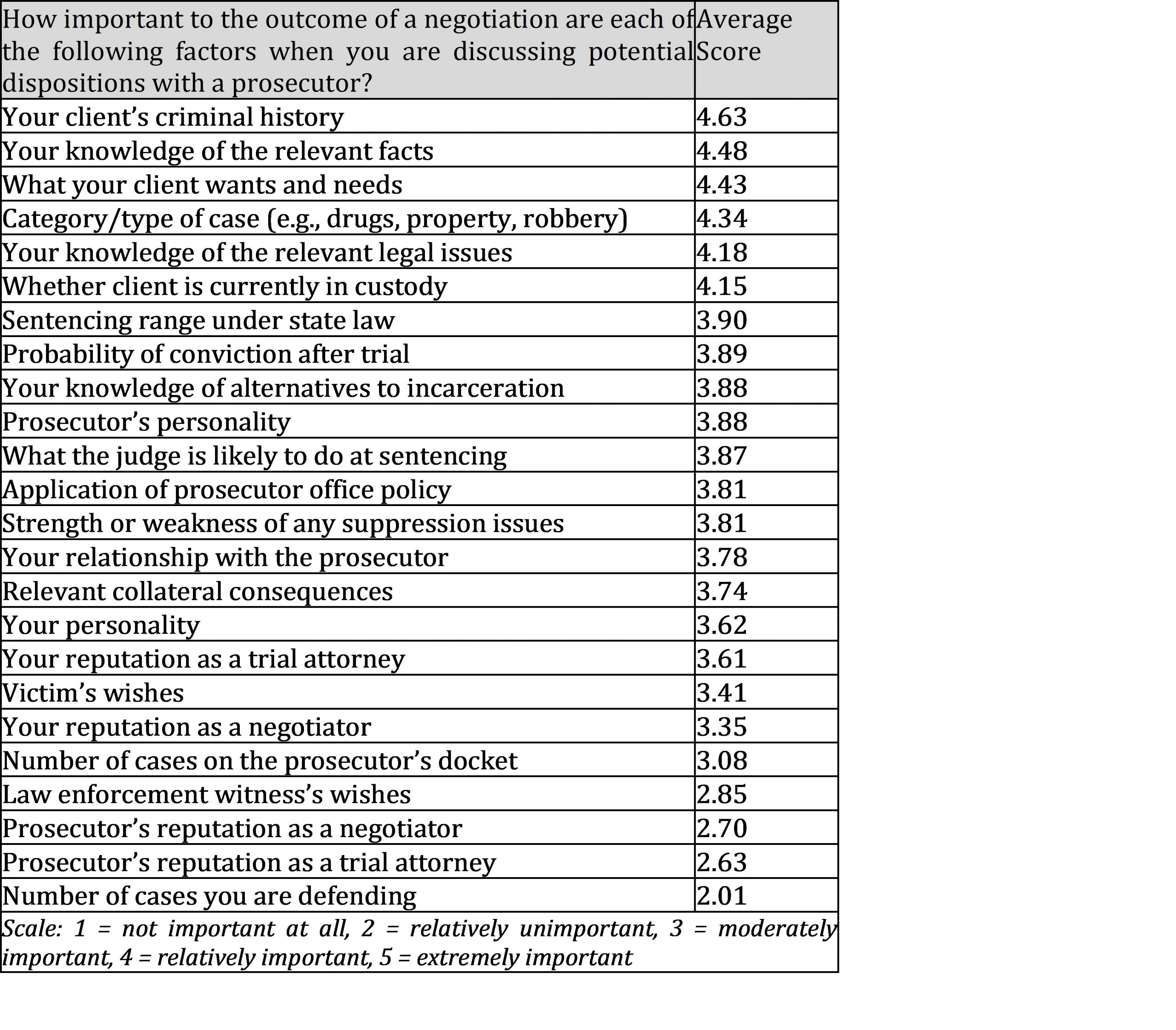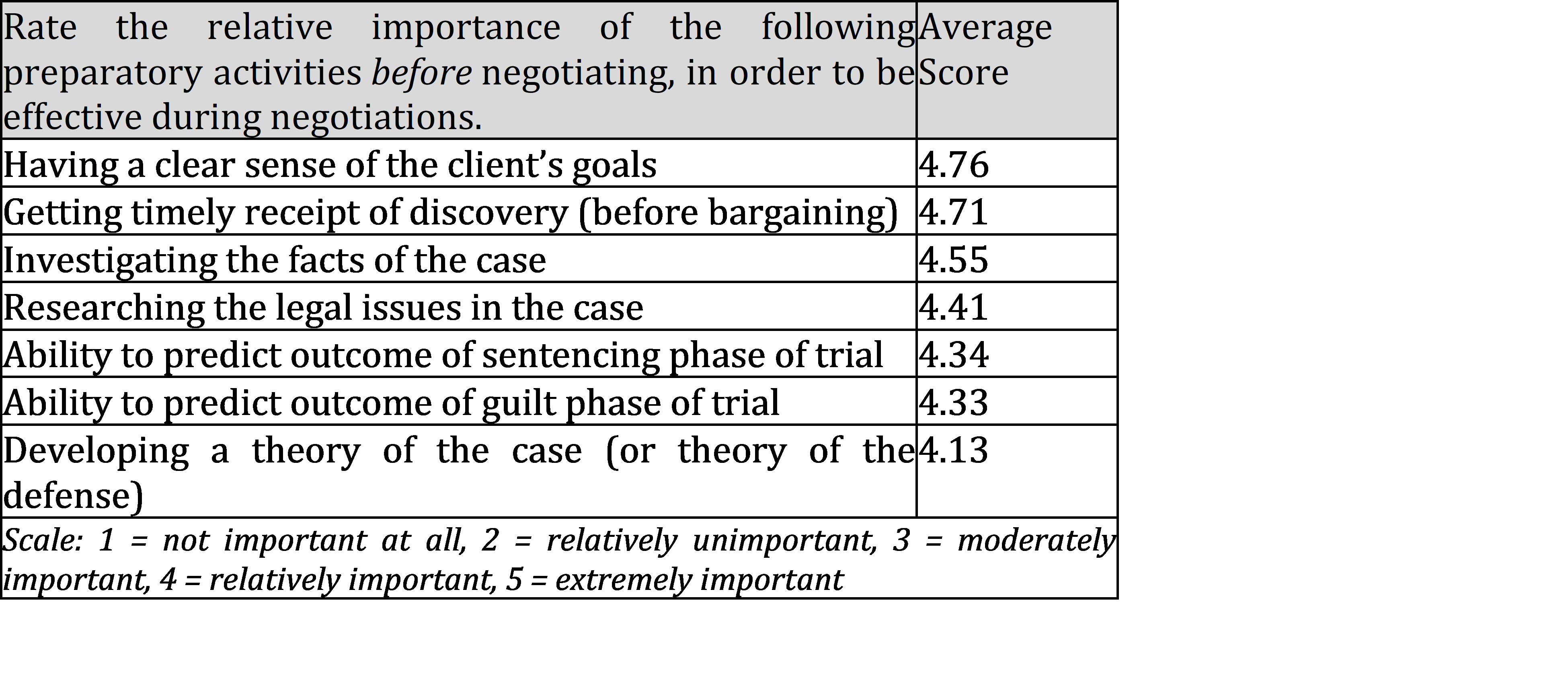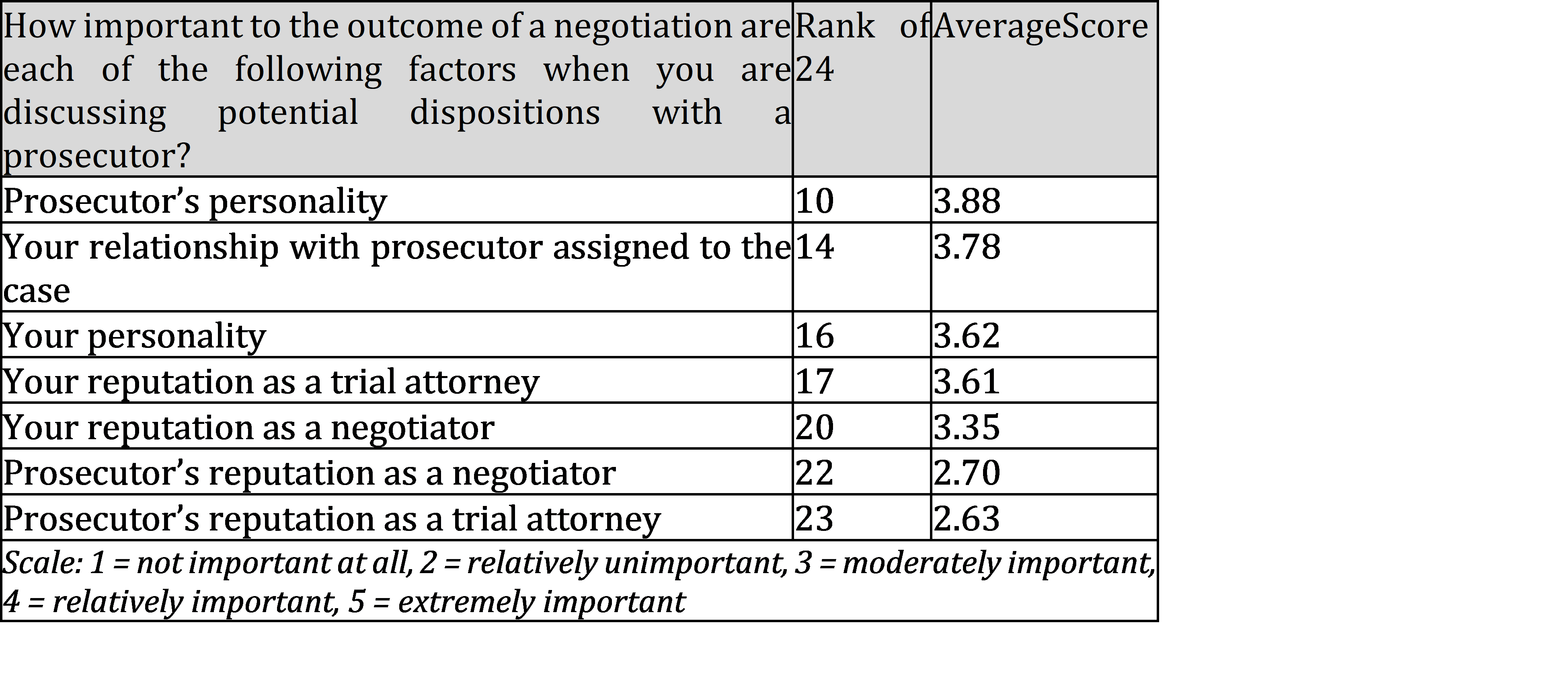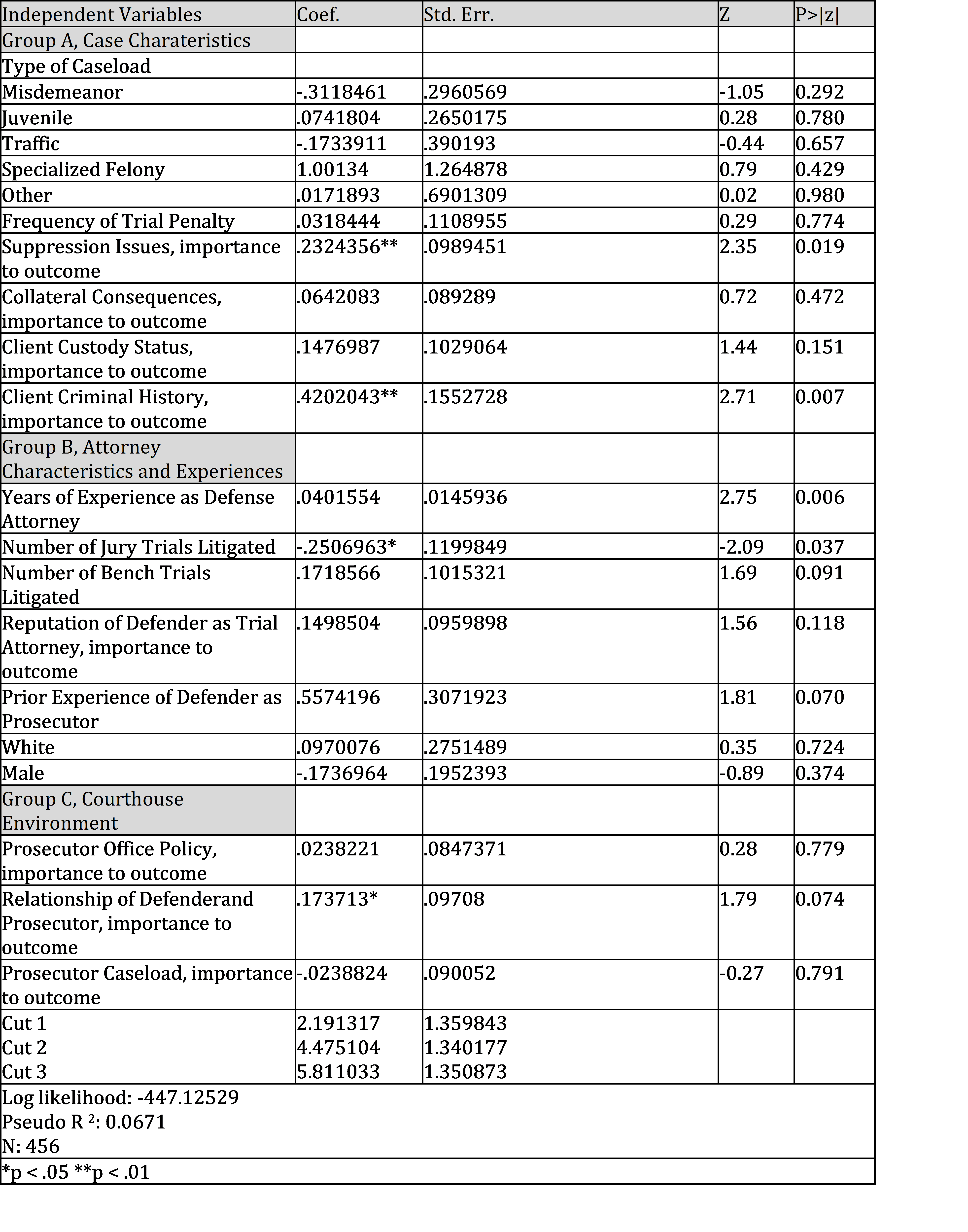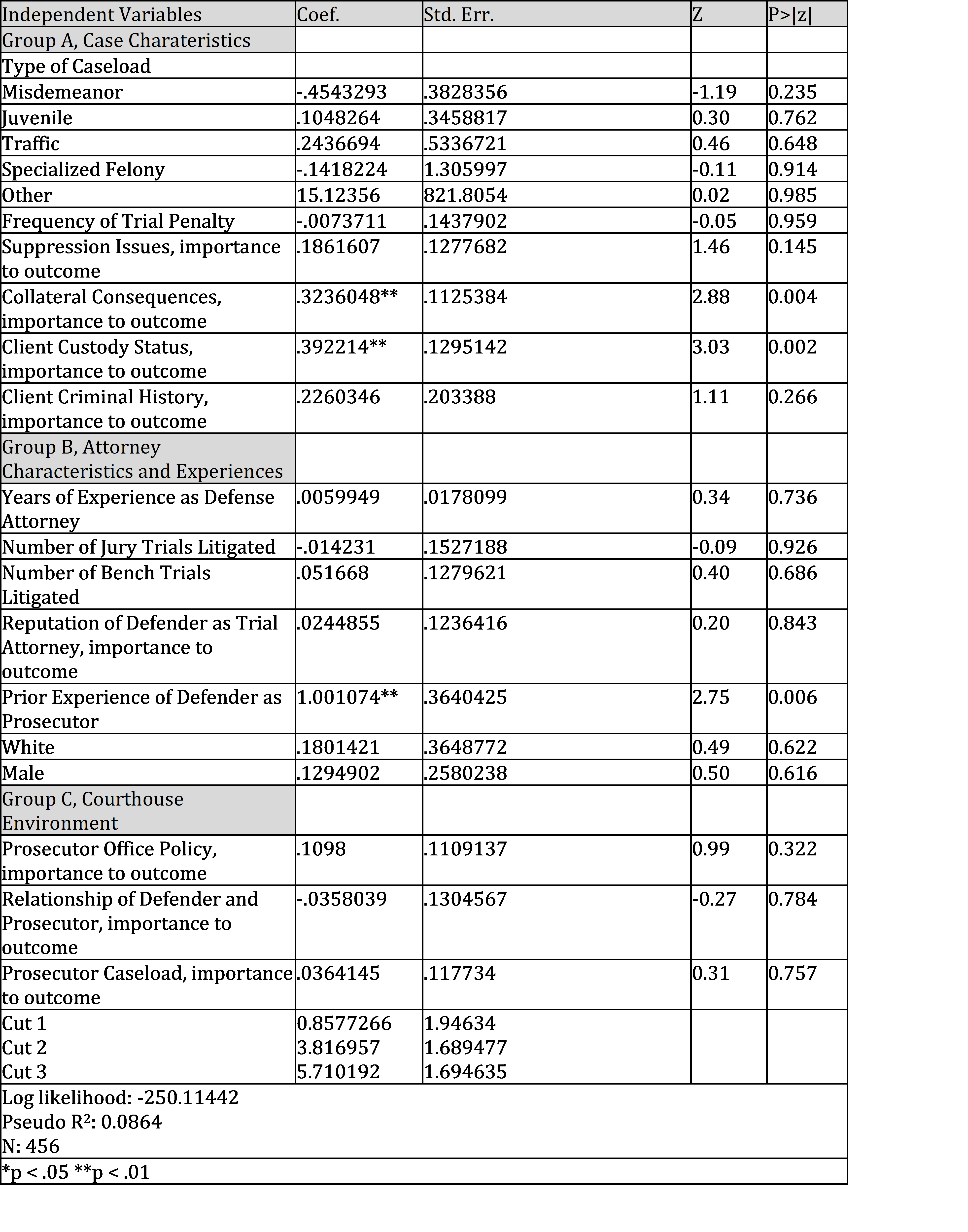Plea bargaining happens in almost every criminal case, yet there is little empirical study about what actually happens when prosecutors and defense lawyers negotiate. This Article looks into the bargaining part of plea bargaining. It reports on the responses of over 500 public defenders who participated in our nationwide survey about their objectives and practices during plea negotiations.
The survey responses create a rare empirical test of a major tenet of negotiation theory, the claim that attorneys bargain in the “shadow of the trial.” This is a theory that some defenders embrace and others reject. Describing the factors they believe to be important in plea negotiations, some public defenders—those who emphasize the importance of collateral consequences or the pre-trial custody of their clients—do not stress the likely outcome at trial. Instead, these attorneys focus on the wants and needs of clients, hoping to persuade the prosecutor to operate outside a trial-prediction framework. These defense attorneys might ask the prosecutor to dismiss charges, to divert the defendant out of the system, or to recommend a sentence far below the expected outcome. Such dispositions based on equitable factors, many of them related to the larger life circumstances of the defendant, point the prosecutor toward an outcome that is independent of any likely trial result or post-trial sentence. These defense attorneys, we argue, bargain in the “shadow of the client” rather than the shadow of the trial. Multivariate analysis of the survey answers allows us to identify which attorney background factors correlate with each of the distinct theories of negotiation.
After asking public defenders about their plea bargaining aspirations, our survey turns to actual negotiation practices. Here, defenders’ self-reported bargaining methods do not measure up to their declared aspirations. Their own descriptions of the fact investigations and legal research they typically perform ignore some viable outcomes that their clients might prefer. Particularly for attorneys who aim to negotiate in the shadow of the client, there is a wide gap between theory and practice.
I. Introduction
Anybody who wants to understand or improve criminal justice in the United States must learn how plea bargains work. And there is plenty to learn about the outcomes of this process—the plea part of plea bargaining. Empirical studies show differences in outcomes based on the crime charged, the race and gender of the defendant, and other background conditions.1
On the other hand, it is much harder to learn what actually happens during the negotiations between a prosecutor and defense lawyer and what preparation occurs before the bargaining starts.2 In short, we know relatively little—empirically speaking—about the bargaining part of plea bargaining. This is unsurprising in some respects, because negotiations happen behind closed doors or in rushed hallway meetings; they involve conversations between people who lack the time and incentive to record their strategies or interactions.
The field realities of the bargaining process deserve study, both in doctrinal and theoretical terms. Consider first the importance of negotiation behavior in terms of legal doctrine. Over the last decade, the Supreme Court has shown belated interest in plea bargaining. For now, the Court has lightly regulated the conversations about guilty pleas that defense counsel and judges conduct with defendants.3 The Court has yet to enter the thicket of actual bargaining—the conversations between the defense counsel and the prosecutor.4 That next step may arrive soon, though, as lower courts encounter claims of ineffective assistance of counsel during bargaining exchanges with prosecutors.5
In short, legal doctrine about plea bargaining has brought us to the gateway of a regulatory era. At such a moment, shouldn’t we know—as wise regulators—what actually takes place in the bargaining halls?
Consider second the theoretical insights that might result from learning about the nuts and bolts of plea bargaining. The tenets of negotiation theory, which developed in the contexts of labor contract negotiations and civil litigation,6 have not seeped very deeply into the ground of the criminal courts.7 Criminal practitioners routinely say, “I just don’t think it’s something that can be taught.”8 A catalog of actual bargaining practices among prosecutors and defense attorneys, therefore, could show whether the positive theory of negotiation—developed in another litigation context—applies with equal force to criminal adjudication. Scholars might also predict the impact if the normative insights from negotiation theory (its framework of best practices) were to become more common in criminal practice.
So we went out into the field and asked. We began our research with semi-structured interviews with public defenders in four states, asking them about their negotiation practices and the factors they believed to be important during a plea negotiation. Based on what we heard during those interviews, we developed a survey and received responses from public defenders in every region of the country.9
Through the survey results, attorneys told us what they typically do to prepare for plea negotiations and described, step-by-step, their ordinary interactions with prosecutors during the negotiation itself.10 Even more important, public defenders opined about the practices and background conditions that could make the biggest difference during an idealized negotiation.
The survey answers therefore reveal latent theories of negotiation that defense attorneys pursue, even if imperfectly. One of those implicit theories is consistent with the traditional idea that litigators bargain in the “shadow of the trial.”11 According to this view, the most important drivers of negotiation outcomes are the likely outcome at trial and the probable sentence imposed after trial. Defense attorneys who negotiate in the shadow of the trial picture specific procedural stages at trial and at the sentencing hearing. According to this theory, they would negotiate based on the likely effects of legally relevant features of the defendant and the offense.
A second implicit theory of negotiation that emerges from the survey is grounded in a bit of conventional wisdom: attorneys believe that they should attach the highest importance to the client’s “wants and needs.” At first blush, it is not surprising that attorneys claim to put a high value on client wishes, as their ethical obligations require them to do.12 What is striking about this claim is how some attorneys compare this starting point principle to other possible influences on negotiation outcomes. These attorneys rate their clients’ wishes as more important to the outcome of a negotiation than their own caseloads, more important than the personalities and reputations of the negotiators, and even more important than the predicted outcome at trial or at sentencing.
According to this second theory of negotiation, defense attorneys would persuade the prosecutor to evaluate their client’s situation outside of a trial-prediction framework. They might ask the prosecutor to divert the defendant out of the system, to dismiss charges, or to recommend a sentence far below the expected outcome for the current charge. During these plea negotiations defense counsel could appeal to equitable factors, many of them related to the larger life circumstances of the defendant. These factors might point the prosecutor towards an outcome that is the right thing to do, independent of any likely trial result or post-trial sentence.
Thus, the defense attorneys who responded to our survey disagreed about the type of shadow that matters during plea negotiations. The shadow of the trial drives the outcome for some, while for others, what matters are broader, sometimes extra-legal factors. We call this expanded theory a negotiation in the “shadow of the client.”
The alternative “shadow of the client” theory of negotiation applies, to some degree, to all types of attorneys. But the choice between the two shadow theories is not random, either. The influence of the “shadow of the client” theory is strongest among attorneys who place the greatest weight during negotiations on a client’s pretrial custody and on collateral consequences. On the other hand, attorneys with the most years of experience as public defenders and those who emphasize the importance of suppression of evidence issues tend more often to adopt the “shadow of the trial” theory. We conducted a multivariate analysis of the survey results to understand how these different background factors interact to produce two distinctive negotiation theories.
Our discussion of negotiation theory and practice follows a simple organization. In Part II, we review the empirical scholarly literature on plea bargains, including its emphasis on the outcomes and the lesser attention devoted to the bargaining process itself. In Part III, we describe the methodology of our survey, evaluating the limits and potential of this data. Then in Part IV, we analyze what attorneys declare to be important in the bargaining process. We detail how their priorities stress either the shadow of the trial or the shadow of the client’s expressed wants and needs as the primary influence on their preparation for negotiation.
Finally, Part V tests the self-declared negotiation goals of defense lawyers, measured against what they assert about their actual practices during negotiation. Their self-described habits depart in important ways from their own declared vision of sound negotiation practices. For example, when it comes to fact investigation, file review appears to be the strong suit of defense attorneys across all types of cases. Other forms of factual investigation, such as witness interviews and site visits, occur less often, even in categories of cases where such investigation might prove useful. As for knowledge of the relevant law, attorneys say that they engage in research less often than they investigate facts. This is particularly true of misdemeanor attorneys, where the client could often benefit from testing the legal viability of the prosecution’s case. Finally, defense attorneys tend to remain passive in the timing of their negotiations, waiting in most cases for the prosecution to make a first offer. This timing habit persists even in those situations where a first offer from the defense is unlikely to do any harm.
In each of these aspects of negotiation, defense attorneys report practices that do not measure up to the shadow of the client theory of bargaining. They leave unexplored some viable options that the client might prefer, leading to bargains that were negotiated outside the shadow of the client’s interests.
II. The Outputs, the Inputs, and the Kitchen
The empirical study of plea bargaining extends back for almost a century.13 Early on, this field work examined the outputs of the process, such as changes in the disposition method for cases filed, the speed of case disposition, or the severity of sentences. Later work examined the inputs that shaped those guilty plea outcomes: the nature of the charges, the quality of the evidence to prove those charges, the characteristics of the full-time actors who work in the criminal courts, and the local institutional environment.
Indulging in a culinary metaphor, we think of the inputs to plea negotiations as the ingredients and the outputs as the dishes that emerge from the restaurant kitchen. Empirical research tells us a lot about the ingredients and the dishes but far less about what happens inside the kitchen—the sequence of offers and counteroffers, the priorities of the prosecutor and defense lawyer, and the effects of local negotiation practices on the plea deal. In this Part, we highlight a few examples from the profuse scholarship about the inputs and outputs, before turning to the limited empirical scholarship about what happens in the kitchen.
A. Outputs and Inputs
The outputs of plea negotiations attracted the attention of criminal justice scholars in the early twentieth century. A series of state-level studies during the 1920s and 1930s announced the discovery of a surprising new reality in the criminal courts: the large proportion of criminal cases resolved through “compromises” rather than trials.14 The relative importance of trials and guilty pleas remains a topic of interest to legal scholars, criminologists, and others.15
Output scholarship also deals with the precise forms that these compromises take. Sometimes they result in reduced charges, while in other settings the negotiations lead to lower recommended sentences even without a reduction of charges.16 Access to court data allows scholars to study sentencing severity and the differential between outcomes after trial and after a guilty plea—the gap known as a “trial penalty” or “plea discount.”17 Various field studies also examine the output effects of attempts to ban plea bargaining.18 Finally, the accuracy of convictions based on guilty pleas became a serious concern for empirical investigation after the advent of the “innocence movement.”19
Scholars of plea bargaining also address the ingredients or inputs into the plea bargaining process. The literature about the historical origins of plea bargaining tries to explain the conditions that led to growth in this method of resolving criminal charges.20 Field studies track the influence of judges,21 prosecutors,22 law enforcement officers,23 and defense counsel in the selection of cases for early resolution.24 The relationships among the actors within courtroom workgroups also get scrutiny.25
Criminologists, economists, political scientists, and criminal justice scholars have contributed important insights about the raw materials available to the bargaining parties in local courts. The volume of cases in the court system seems to increase the number of pleas.26 The seriousness of the charges,27 the statutory charge and sentence options available to the negotiators,28 bail practices,29 and the policies of the offices where the negotiators work all influence the number and type of pleas.30 Victim characteristics have some effect on negotiated outcomes.31 The gender,32 race-ethnicity,33 and other characteristics of defendants also explain some aspects of plea bargaining outcomes.34 Strength of evidence gets its moment in the spotlight as well.35
B. In the Kitchen
The transformation of ingredients into dishes—what happens in the restaurant kitchen—attracts less empirical inquiry. The mechanics of bargaining for a possible guilty plea include the preparations of the attorneys, the interactions between the prosecutor and the defense attorney, the sequence of their offers, the methods of persuasion they use, the relationships between the bargainers, and many connected topics. As criminologists Johnson, King, and Spohn noted recently, “few studies include adequate information about the actual negotiated plea bargaining process.”36 The field work, they said, does not “capture the dynamic and recursive nature of plea bargaining.”37 This problem is evergreen, as socio-legal scholars periodically notice the scarcity of field research into the plea bargaining process.38
Despite the paucity of research on the bargaining part of plea bargains, a few empirical studies are relevant to our project. Albert Alschuler opened the door to the plea bargaining kitchen with his seminal field studies of ten urban jurisdictions during the 1960s and 1970s. He catalogued bargaining practices through interviews with defense counsel,39 prosecutors, judges, and other courtroom regulars.40 Despite its informal journalistic methodology, this work identified key areas that still influence the plea bargaining process, including discovery, strategic delay, judge shopping, judicial pressure, relationships with clients, and case load.41
Over the years since Alschuler interviewed courtroom actors, empirical insights about bargaining practices have arrived through a variety of research methods. The most straightforward studies involve sporadic surveys of defense counsel, asking in general terms about the bargaining practices they typically use or witness. For example, one 1980s survey of 173 criminal defense lawyers in Maricopa County, Arizona “questioned public defenders and private practitioners about their opinions and attitudes toward plea bargaining, and their actual preparation for plea negotiation.”42 A smaller but more geographically diverse group of defenders completed a similar questionnaire.43 Given the age and limited geographic reach of these two studies, they offer only modest insight about current practices.44
Similar findings come from a few field interviews that call for criminal practitioners to characterize their bargaining practices in general terms.45 The interviews often extend to all of the regular courthouse actors, in an effort to capture the subtleties of local culture.46 Direct observations of plea negotiations in a single courthouse have also provided a few glimpses behind the kitchen door.47
Surveys sometimes pose hypothetical cases for attorneys to resolve, based on the practices they normally employ. For instance, a 1986 study used case vignettes to demonstrate that when the severity of the sentence and probability of conviction increased, prosecutors became less willing to plea bargain and defense attorneys became more willing to do so.48
While the empirical picture of defense attorney negotiation practices is sketchy, the portrait on the prosecutorial side of the bargaining process offers more detail. A number of older studies take a close empirical look at various influences on prosecutor decisions during negotiation.49 After several quiet decades, field research about prosecutor bargaining choices has been reinvigorated lately.50 Similarly, the empirical account of the judge’s role in plea negotiation was developed in early studies,51 with recently renewed interest in the topic.52
In sum, the empirical studies of defense counsel practices during plea negotiations rely on multiple methods, but they do not provide as much depth as the studies of judges or prosecutors. In particular, there is little multi-jurisdictional research on the defense side.53 Furthermore, the empirical scholarship, taken together, does not generate or test any theories of negotiation.
III. Survey Methodology
Early theoretical accounts of plea bargaining stressed the rational prediction by the relevant actors of likely outcomes after trial.54 Over the years, these accounts of plea negotiations made greater allowances for decision-making that went beyond a pure trial-outcome analysis, as detailed in behavioral economics.55 Until now, however, not much empirical investigation has tested the evolving theory.56
In light of this gap,57 we wanted to find out more about the defense attorney’s objectives during plea negotiations. More specifically, we hoped to learn whether defense attorneys embrace the economic insights built into the “shadow of the trial” negotiation theory, or if they instead pursue an alternative set of negotiation objectives.
Our field study involved two mutually reinforcing sources of evidence. First, we conducted fifteen semi-structured interviews in eight public defender offices, divided among four different states. These field interviews lasted thirty to sixty minutes each. The recorded interviews touched on topics such as local prosecution office policies about plea offers, informal rules of bargaining, and sentencing laws and practices.
Those interviews helped us refine the questions to ask in an online survey.58 We distributed the survey to 2,265 public defenders, working in thirty-one offices across thirteen states.59 Responses came from 579 attorneys, for a response rate of 26%. Of those responding attorneys, 44% identified as female; among those who indicated race or ethnicity, 86% were white, 8% African American, and 4% Hispanic. In terms of seniority, 36% of the respondents had zero to five years of experience as defense attorneys. There were 15% with experience between six and nine years, 29% between ten and twenty years, and 20% with more than twenty years of experience. A significant minority (12%) worked as prosecutors at some point before taking their current positions as public defenders.
As for their current assignments, 21% of the responding attorneys were devoted to representing clients charged with misdemeanors, spending more than half of their hours on misdemeanor cases.60 About 40% of the attorneys spent more than half of their hours on general felony matters, and 8% of the attorneys specialized in particular types of felonies.61
The survey asked first about the relative importance of various influences during typical negotiations. It went on to ask for details about the timing of negotiations, the frequency of various discovery practices, characteristics of first offers, the duration of negotiations, the channels of communication, the frequency of various negotiation tactics, activities of the attorney in preparation for bargaining, consultation with peers about bargaining, and training about bargaining.62
We use several methods to analyze the survey responses. Simple descriptive statistics allow us to spot potential patterns, where attorneys from one type of background answered questions differently from attorneys from another background.
It is important for us to consider how the answers to different survey questions interacted with one another, so we also conduct a multivariate analysis. We divide the answers to several survey questions into content groups. One set of questions deals with case characteristics.63 A second group addresses the background, characteristics, and experiences of the defense attorney.64 Questions in the third group speak to the courthouse environment where negotiations take place.65 A fourth group addresses the attorneys’ expressed beliefs about important negotiation objectives, which indicate an embrace of the shadow-of-trial theory or the shadow-of-client theory of negotiation.66
We believe that case characteristics, attorney background, courthouse environment, and attorney beliefs about negotiation objectives influence the way that attorneys prepare for negotiation. Put another way, we hypothesize that answers to the first four groups of questions (independent variables) should show a statistically significant association with some survey answers related to preparation for bargaining (the dependent variables).67
One final group of questions deals with attorney practices during negotiation. They include several factors that we associate with a shadow-of-trial theory; other behavioral claims we connect to a shadow-of-client theory.68 An additional layer of analyses asks whether answers from the first five groups (case characteristics, attorney characteristics, courthouse environment, beliefs about negotiation objectives, and preparation for negotiation) have any combined effect on self-reported practices during negotiation.69
The design of this study imposes some important limitations on us. First, because we asked defenders to report their own bargaining practices, we should interpret their responses with care. Self-reported data from surveys used in other contexts (such as policing) routinely lead to results that cast the study subjects in too favorable a light. Predictably, the respondents hesitate to report themselves as departing from ethical requirements, relevant policies, or best practices.70 This limitation applies most emphatically to survey answers dealing with attorney descriptions of their own performance for clients; it also applies, but perhaps with less force, to answers related to negotiation practices in general.
Second, we did not obtain access to caseflow data from the courts across the thirty-one jurisdictions we studied. That data might have offered some check on the accuracy of defense attorney claims about the volume and types of cases in the system. But the collection of data from these far-flung court systems was not feasible for this study. Finally, given the voluntary nature of the survey, we probably received responses from the most active and conscientious defense attorneys in each office.
Despite these limitations, we believe that self-reported survey answers offer some insights about activities that are difficult to study because they generally take place behind closed doors with no other parties present.71 In particular, these answers merit our attention when the attorneys speak about what should matter in negotiation, as opposed to the actual practices that they claim to follow.
IV. Defenders’ Implicit Theories About Plea Bargaining
Our survey questions asked about the “importance” of various factors to the outcome of negotiations and to preparation for bargaining. Hence, the attorney responses to these questions make it possible to identify their aspirations for the bargaining process—the actions they believe they should take and the external conditions they hope to find or create for their clients. Their ratings of the importance of different factors amount to an implicit theory of negotiation based on field experience. In this Part, we compare two of these implicit theories of negotiation; each account offers a simplified narrative to explain how one might understand a complex practice.
The first take on what matters in bargaining comes from negotiation theory, which scholars and practitioners developed in civil cases and later applied to the criminal context. Negotiation theory highlights two principles as central to bargaining. The first principle is that parties bargain in the shadow of trial, meaning that the predicted outcomes at trial, and at sentencing after trial, form the baseline for negotiations.72 A second theoretical principle, much studied in the civil negotiation context, is that the negotiators’ personal styles, as well as their reputations as trial attorneys and as negotiators, play a significant role in the actual bargaining process.73
A second theory of negotiation is also visible in the survey data, one that we call “bargaining in the shadow of the client.” This strategy emphasizes the individual qualities of the client, such as the importance of collateral consequences for some defendants. Attorneys treat a wider range of factors as important to negotiation outcomes, including equities that reveal the client’s relative lack of blameworthiness, rather than a central focus on legally sufficient proof of crime elements.74
Defender responses to two categories of survey questions capture the choice between these two theories of negotiation. First, in the “Negotiation Practices” section of the survey, we asked defenders to score the importance of twenty-four factors to the outcome of a negotiation on a scale of one to five (“not important at all” to “extremely important”). The attorneys who place the highest priorities on several trial-centered factors—such as “likely outcome after trial” and the “likely sentence”—signal their belief in the “shadow of the trial” theory.
Second, the “Preparation for Bargaining” section of the survey asked defenders to rate seven preparatory activities for their importance to effective bargaining. The attorneys who assigned higher importance to predictions of trial outcomes and sentences point once again to the traditional “shadow of the trial” theory. Tables 1 and 2 list the average scores for these two foundational questions.
Table 1: Ranking of Factors Important to Negotiation Outcomes
Table 2: Importance of Preparation Activities
In the remainder of this Part, we explore the differences among the defense attorneys who tend to favor each of these two implicit negotiation theories.
A. The Two Shadows
A trial throws its shadow based largely on external factors that require a somewhat objective evaluation from both sides in a negotiation. Even if one negotiator does not agree with the other side’s predictions, there are common data points to discuss, such as the governing law on confessions or the aspects of the defendant’s past that the jury is likely to hear.
But a lot of bargaining appears to happen in an entirely different shadow, one cast by the defendant’s life situation. These factors enter the negotiation early, when the defense attorney presents the mitigating context for the crime as charged. When defenders work to secure dismissal, diversion, or a plea offer based on their clients’ family, employment, health, or other personal circumstances, the negotiation occurs in the shadow of those factors and not just the likely outcome at trial or the relevant legal factors that structure the sentence.75 These factors, even if they would not be admissible at trial or central at sentencing, are important considerations for a prosecutor who wants to do justice.76 Unlike trial predictions and some sentence predictions, these client-specific factors tend to be internally focused and subjective.
Personalizing one’s client has long been considered valuable in a negotiation. Client-centered approaches to lawyering focus on individual autonomy and empowering clients to make decisions for themselves.77 This conception of the attorney’s role offers an alternative to the traditional model, where lawyers take a client’s basic goals into account but use their own professional judgment to explore options and then present a recommendation to the client.78
Our survey asked two questions directly related to the shadow of the client perspective:
(1) How important to a negotiation outcome is “what your client wants and needs”?
(2) How do you rate the relative importance of “having a clear sense of your client’s goals” as a preparatory activity before negotiating, to be effective at bargaining?
At first glance, the answers to these questions do not meaningfully distinguish defense attorneys from one another. Both got high rankings from all subtypes of attorneys, cutting across gender, race, experience level, and type of caseload.79
After a closer look, however, there are some background experiences that distinguish the attorneys who rated the client’s goals most highly as a focal point for their preparation for bargaining. Take collateral consequences, for instance. Collateral consequences are “the range of legal penalties and disabilities that flow from a criminal conviction over and above the sentence imposed by the court.”80 These matters are irrelevant at trial and are too often peripheral to a typical sentencing hearing.
In our pre-survey interviews, attorneys described how they used collateral consequences during a negotiation. For example, one defender described a prosecutor’s plea offer in a reckless driving case that included suspension of the client’s license. For the client, however, it “was a nonnegotiable for him to have his license suspended.” So, when the defender responded to the offer, she explained to the prosecutor that “‘he needs to drive; he needs to drive to pick his daughter up.’ So that’s a non-negotiable.”81
In theory, we would expect defenders who adopt a shadow-of-client approach to negotiation to assign a higher score to the importance of “collateral consequences of a conviction for your client.” And indeed, attorneys handling misdemeanor caseloads82 did score the importance of collateral consequences at 4.09, “relatively important.”83 This result reinforces the special importance of client priorities for these attorneys, since collateral consequences are comparatively more important in misdemeanor cases, where they can easily be the most severe consequences for some defendants, such as those who need to keep their occupational licenses or driving privileges.84
But it is too simple to conclude that misdemeanor attorneys embrace the shadow-of-the-client theory. While misdemeanor attorneys do tend to value collateral consequences in bargaining, there are also felony attorneys who emphasize collateral consequences. According to our multivariate analysis of survey answers, the importance of collateral consequences for negotiation outcomes has a statistically significant and positive predictive effect on the role of client goals during preparation for bargaining. This remains true even after controlling for the type of caseload that the attorney handles.85 It is the attorney’s focus on collateral consequences, rather than a misdemeanor caseload as such, that makes a difference.
Some attorneys also placed high importance on the fact that their clients remain in custody during negotiations. This suggests to us that plea bargains are driven by factors that are not directly connected to strength of evidence, and therefore would be more important for the shadow-of-the-client theory.86 As we expected, attorneys who placed heavy weight on the client’s custody during negotiations were more likely to score higher on shadow-of-client indicators, such as the importance of the “client’s goals.”87 The custodial status of the defenders’ clients remained important even after controlling for other characteristics of the attorneys’ caseloads, courthouse environments, and personal backgrounds.88
B. Attorneys Who Emphasize Factors Most Relevant to Trial
Under the shadow-of-trial theory, the parties predict trial outcomes in large part by estimating the strength of the likely evidence at trial and then multiplying that probability by the likely sentence after trial.89 While the shadow-of-trial theory has been critiqued,90 “overwhelmingly, legal scholars view the shadow of trial as an accurate description of the plea bargain decision-making process at the individual case level.”91
A corollary to the shadow-of-trial theory is a core teaching of negotiation strategy, namely that the bargaining parties should be aware—and bargain against the backdrop—of the “Best Alternative to a Negotiated Agreement” (BATNA).92 In criminal cases, where alternatives to a negotiated plea agreement are limited, determining the BATNA requires a calculation of the likelihood of conviction and the likely sentence after a conviction. While there are certainly other components to a BATNA,93 the shadow of a trial looms large in this core negotiation strategy as it applies in criminal cases.
If it were true that attorneys in a plea negotiation generally bargain with the shadow of trial foremost in their minds, we would expect two factors in particular to rank near the top of the importance-to-negotiation-outcome scale: “probability of conviction on all charges if case were to go to trial” and “what the judge is likely to do at sentencing in cases like this.” These two factors, however, rate as more important for some attorneys than for others.
In particular, the number of years of experience matters for attorney ratings of these two shadow-of-trial factors. As Table 3 indicates, attorneys with eight or more years of experience answered these two questions more consistently with a shadow-of-trial theory, while attorneys with fewer years of experience (even those with enough years to handle felony cases) answered more in keeping with a shadow-of-client theory.94 Years of experience remains a significant factor even after controlling for other variables, such as felony caseloads and the number of bench trials or jury trials that the attorney has litigated.95
Table 3: Average Scores for Importance of Probability of Conviction or Likely Sentence, by Years of Experience
The strength of any “suppression issues” is another factor with a persistent impact on trial outcomes but little relevance to understanding the broader context of the defendant’s life. In short, it is another question that one would expect to receive the highest scores from attorneys who most clearly embrace the shadow-of-trial theory. Our multivariate analysis confirms this expectation. Attorneys who emphasize the importance of “suppression” issues are statistically more likely to treat the probable trial outcome as an important factor in their preparation for bargaining. In short, they operate within the shadow of the trial.96 Overall, the “shadow of the trial” theory of negotiation matters more for the most experienced attorneys, particularly those who stress the importance of motions to suppress evidence (possibly because their clients tend to present such issues more frequently).97
The defendant’s criminal history, in theory, could relate to both the shadow-of-trial and the shadow-of-client models of negotiation. A defendant’s prior convictions might not factor heavily into the likelihood of a conviction at trial because most defendants do not testify at trial and their priors are not usually in evidence.98 On the other hand, criminal history could matter to attorney predictions of the sentence (another indicator of a shadow-of-trial approach to negotiation) because criminal history plays such a central role in sentencing law.
Over on the shadow-of-client side of the ledger, criminal history could matter during negotiations, regardless of any effect on the trial outcome or post-trial sentencing. It matters instead for the prosecutor’s willingness to drop below the market rate for the charged offense, taking a chance on the defendant’s future prospects. This factor shows how disconnected plea bargaining can be from the guilt or innocence of the defendant.99
Consistent with these expectations, our multivariate analyses show that criminal history matters both to shadow-of-trial preparation and to shadow-of-client preparations for negotiation. Attorneys who placed the most importance on criminal history were statistically more likely (after controlling for other variables) to stress trial predictions and sentence predictions as part of their preparation for bargaining, two indicators of a shadow-of-trial orientation.100 At the same time, attorneys who placed the greatest importance on criminal history were also more likely to emphasize gaining knowledge of alternatives to incarceration, an indicator of a shadow-of-client mindset.101
C. Attorneys Who De-Emphasize the Role of Caseloads in Negotiation
Defenders in our survey report that their caseloads at the time of a negotiation are relatively unimportant to the outcome of that negotiation. This is perhaps our most surprising result, given the common wisdom that high volume is a primary driver of our bargain-based system of criminal justice. The response highlights the uncertainties involved in self-reported survey data.
Table 4: Importance of “number of cases you are defending at the same time as this case,” by type of caseload
As Table 4 indicates, misdemeanor attorneys averaged 2.13 (“relatively unimportant”), whereas felony attorneys placed even less importance on the factor, at 1.87.102 Defenders rated their own caseload dead last on the list of twenty-four factors for importance to negotiation outcomes.103
Defenders’ beliefs about the unimportance of their own caseloads stand in contrast to other evidence about the pressures of caseloads. There are many studies and news reports highlighting public defense systems that operate under unethically, and sometimes unconstitutionally, high workloads.104 For instance, one Georgia court, in ruling that a defendant could withdraw his guilty plea due to ineffective assistance of counsel, described how the defense lawyer claimed that “he had so many cases on his load, that if he looked into every nook and cranny that there was to this case, that he would never get anything done.”105 In that case, the investigation that the lawyer skipped because of lack of time was the defendant’s claim that he was not actually driving the truck involved in the accident!106
Other more systematic studies of negotiation practices explore the specific link between high caseloads and plea bargaining. For example, an important study of attorney negotiation styles offered high attorney docket loads as one explanation for the unexpected finding: criminal law practitioners reported higher levels of problem-solving (versus adversarial) negotiation than lawyers practicing in other areas.107 Another scholar described high caseloads and limited resources as conditions that “create a perfect storm that encourages high plea rates, discourages negotiation, and contributes to many defendants feeling that they are simply getting processed through the system, but are not receiving individualized attention or justice.”108
In light of these accounts, the survey responses surprised us. Two potential explanations occur to us for this anomaly. First, it is possible that defenders are simply fooling themselves about their ability to get good negotiation outcomes despite the number of cases they handle. Negotiation literature suggests that strong factual and legal preparation enhances negotiation outcomes,109 and this preparation takes time. Time for preparation is precisely what an attorney with a high caseload cannot give to each client.
There is a second potential explanation for the low level of importance assigned to caseloads. The low rating of caseload might align with a narrative that treats plea bargaining as something distinct from trial preparation and prediction. Attorneys might estimate that preparation for trial takes longer than preparation for negotiation. If that is true, bargaining in the shadow of the client offers a second-best way to deal with their time crunch. By remaining alert to negotiation factors that matter outside the context of a time-intensive trial, an attorney invests in a strategy that will produce the best available outcome for the client, given that the attorney rarely has time for trial preparation.110
That being said, we still treat this second explanation as self-delusional. Defenders who downplay the effects of caseload fail to see that preparation for negotiation in the shadow of the client involves the investigation of a broader range of factors, and therefore can take more time than preparation for bargaining in the shadow of trial predictions.
D. Attorneys De-Emphasize Personal Styles and Reputations
Negotiation scholars treat “personal style or strategy or personality” as part of the “common core of negotiation” theory.111 The idea is that a negotiator’s own personality and the interpersonal dynamic between two negotiators have predictable effects on the eventual agreement.112 And there is empirical confirmation to show how rapport between negotiators might affect negotiation outcomes.113
Our pre-survey interviews with public defenders were consistent with the negotiation literature theme that prosecutors’ and defenders’ personal styles and personalities—and the way in which those personal styles and personalities meshed or clashed—were an important aspect of the actual negotiation dynamic and outcome. As one defender from a mid-sized office in the Mid-Atlantic region put it, the “personality of the individual” is important because “there are prosecutors I know I would get a better deal with because of my relationship with them. And there are prosecutors I know I would get a very bad offer because of my relationship with them.” This defender continued, explaining how, “when it comes down to negotiation and plea, [it] really is about the individuals. . . your client, the attorney, and the prosecutor.”114
Similar to personality and personal style, attorney reputation is understood to play an important role in negotiations. In her study demonstrating that defenders and prosecutors reported much higher levels of cooperation (or problem-solving) in their negotiation practices than civil, family, or commercial law attorneys, Andrea Kupfer Schneider offered the “reputation market[]” theory as one potential explanation for this surprising difference in levels.115 Under this theory, because “the geographic area of practice is narrow and the population of prosecutors and criminal lawyers is also limited[,] . . . the likelihood of ongoing relationships, clear communication, and problem-solving behavior could be understood to occur as a result of repeat play among the lawyers.”116
A criminal law practitioner’s reputation as a trial lawyer holds a status similar to his or her reputation as a negotiator. It is a strongly held view among criminal law practitioners that a reputation as a skilled trial attorney—and one who is not afraid to go to trial—is a valuable chip in any plea bargaining session.117 Conversely, the clients of lawyers with perceived poor trial skills or judgment about when to go to trial may suffer the consequences of that reputation.118
Our interviews also confirmed these accounts. One defender noted how the impact of reputation on a negotiation was “the biggest thing that I never saw coming . . . .I know I get deals from DAs that other lawyers don’t because they trust me.”119 Another defender stressed the importance of a strong reputation as a trial attorney: “if you come back with a counter offer and they’re aware that you’re willing to go to trial . . . then I notice that we get a lot better offers from them.”120 A defender from a different office described how, during a negotiation “I would like to think my dealings with the DA and my reputation for trying a case, but also being easy to get along with, makes it easier to talk about stuff.”121
Our survey responses, however, do not match this narrative about the importance of personal style, interpersonal relationships, and reputation of the negotiators in the plea bargaining context. In our survey question asking defenders to rate twenty-four factors for their importance to the outcome of a negotiation,122 there were seven factors related to personality and reputation. As Table 5 demonstrates, defenders rated both parties’ reputations as negotiators and as trial lawyers near the bottom. The prosecutor’s reputation for negotiation and trial were the lowest, both falling between “relatively unimportant” and “moderately important.”123
Table 5: Importance of Personal Style, Reputation, and Relationships in Negotiation
All of these reputational and personality ratings were relatively stable across all groups of attorneys.124
In sum, defense attorneys responded skeptically when the survey asked about the importance of the reputations of the bargainers or the relationships between them. They believed instead that the fundamental inputs to the negotiation were case and defendant characteristics, such as the criminal record of the defendant or the client’s wants and needs. These fundamentals outshone their own typical choice of negotiating styles or their track record of negotiating with the particular prosecutor.
At the same time, the perceived importance of the relationship between the prosecutor and the defense attorney did have a statistically significant effect on the attorneys’ ratings of shadow-of-trial indicators. More specifically, a respondent’s rating of the importance of the relationship between prosecutor and defense attorney to the outcome of negotiations has a statistically significant positive impact on the attorney’s rating of the importance of trial outcome predictions to preparation for bargaining.125 Even though the attorneys as a whole rated this relationship factor as relatively unimportant, differences within those low-level ratings show us that attorneys who place greater weight on prosecutor relationships also believe that trial predictions and sentence predictions should be central to their preparation for plea bargaining.
V. The Gap Between Implicit Theory and Self-Declared Practice
This Part compares what defenders report as important during negotiations in general to what they claim to do in their own cases. As always, self-reports about job performance should prompt us to interpret the survey answers cautiously. But to the extent that the answers reveal an internal conflict between theory and practice, we might reasonably conclude that the survey answers understate the size of the gap.
Three sets of questions allow us to look at this gap. First, in the “Negotiation Practices” section of the survey, we asked defenders to score the importance of twenty-four factors to the outcome of a negotiation; Table 1 describes their answers. Second, in the “Preparation for Bargaining” section, the survey asked defenders to rank seven preparatory activities for their importance to effective bargaining (as summarized in Table 2). Third, the survey asked attorneys to note the frequency with which they personally engaged in nine activities as they prepared for negotiations in their own cases, from “never” to “always.” The full list of those preparation activities appears in Table 6.
Table 6: Frequency of Activities in Preparation for Negotiation
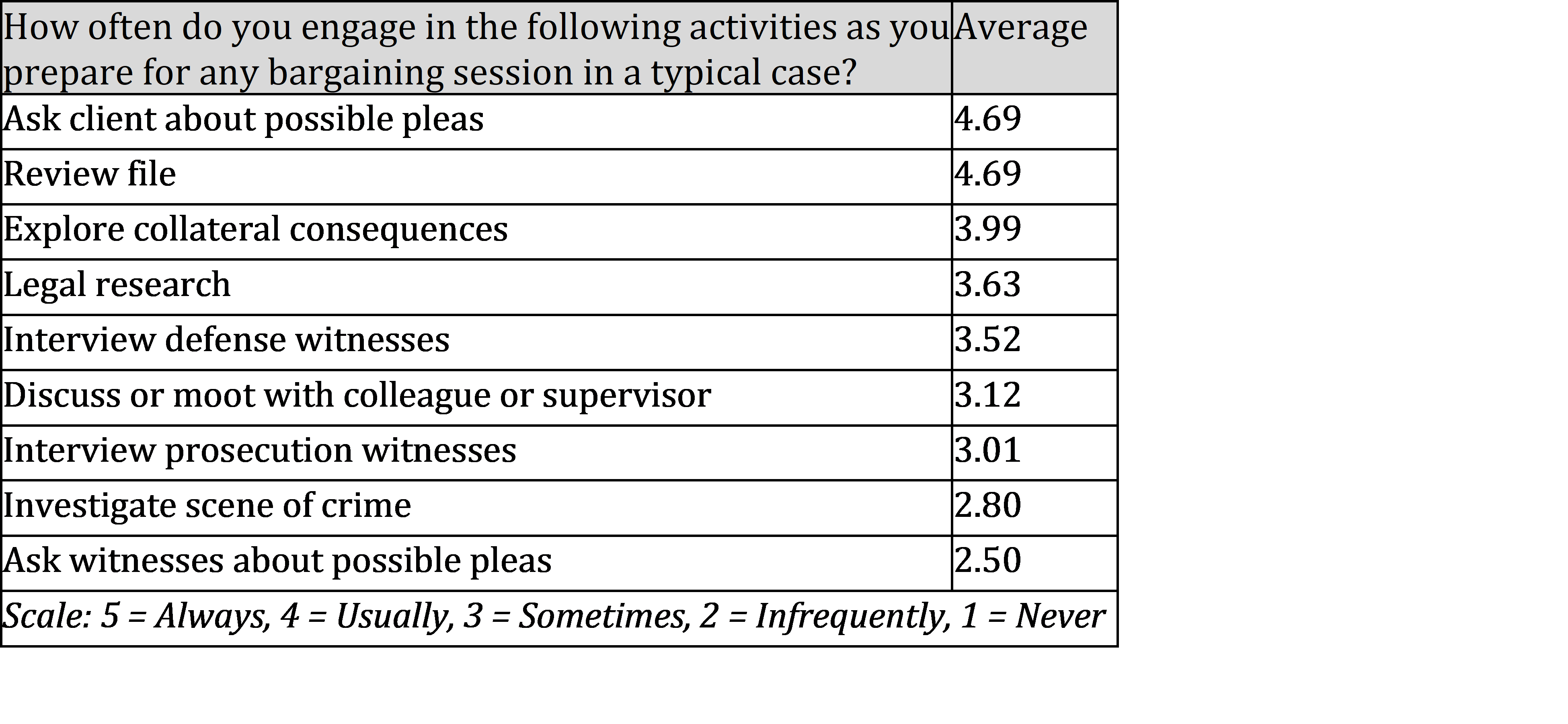 Defense attorneys do link their ideas about negotiation outcomes to their views about how best to prepare for bargaining. That linkage reflects a consistent and coherent theory of negotiation on their part. Thus, attorneys who stress shadow-of-trial factors as important to the outcomes of negotiations also say that shadow-of-trial factors are important to their preparation for bargaining.126 The same is true for shadow-of-client factors: attorneys link their beliefs about outcomes to their preparation.127
Defense attorneys do link their ideas about negotiation outcomes to their views about how best to prepare for bargaining. That linkage reflects a consistent and coherent theory of negotiation on their part. Thus, attorneys who stress shadow-of-trial factors as important to the outcomes of negotiations also say that shadow-of-trial factors are important to their preparation for bargaining.126 The same is true for shadow-of-client factors: attorneys link their beliefs about outcomes to their preparation.127
When we turn, however, to the self-reported practices of attorneys during negotiation (as opposed to preparation before negotiation begins), the relationship between attorney beliefs and their self-declared practices becomes weaker. A theory-to-practice gap opens up.
For instance, one might associate a willingness to signal a vigorous motions practice with the shadow-of-trial theory of negotiation, because this practice stresses legal factors relevant at trial rather than equitable factors related to the client’s larger story. Yet this bargaining practice happened (or reportedly happened) less often for attorneys who otherwise seem committed to the shadow-of-trial theory. Strong attorney views about the importance of trial predictions and sentence prediction to the outcomes of negotiations (two indicators of a shadow-of-trial viewpoint) have a statistically significant negative impact on scores for the self-reported frequency of signaling a vigorous motions practice. The attorneys most committed to shadow-of-trial theory are the least likely to say that they make a strong investment in pretrial motions.128
More generally, our multivariate analyses point to a separation between beliefs about effective negotiation and attorney claims about negotiation behavior. The analyses offer no clear example that attorney beliefs about factors that should matter during negotiation (their implicit theories of negotiation) do indeed have a predictable impact on the practices that attorneys claim to follow during negotiations.129
In an effort to map the precise location of these gaps between theory and practice, we explore in the following subsections the insights one might draw from several pairs of questions. Each pair exposes the gap between what attorneys declared to be important and what they described as their actual practices. Attorneys appear to be missing opportunities in factual investigation, legal research, and the timing of bargaining moves.
A. Learning About Relevant Facts
Negotiation literature teaches that knowledge is power.130 In plea bargaining, prosecutors are generally thought to hold more power than defense counsel and defendants.131 But solid preparation—knowing the law and the facts—is one way to counteract that power imbalance in a negotiation.132
For defense counsel in a criminal case, this means gaining knowledge of the facts of the case through investigation. For example, in one study from 1981, defense attorneys reported an improved position during plea negotiations when they “interviewed prosecution witnesses and conducted extensive fact investigations.”133 Getting information from the prosecution during the actual negotiation process is also an important tool.
Our interviews showed that defenders understood the importance of gathering facts from the very first client contact. For example, one attorney described how “at no point do you really start negotiations without having talked to your client, having at least . . . your client’s story so that even when you start the negotiation—if you only start with the same facts the state has you pretty much lock yourself into whatever version they come up with.”134
In their survey responses, defenders also recognize the power of early factual investigation. As noted in Table 1, defense attorneys report that their knowledge of the relevant facts of a case is between “relatively” and “extremely important” to the outcome of a negotiation, with an average score of 4.48.135
Yet when it comes to their reports of actual preparation related to knowledge of the facts, defenders’ responses are mixed. Defenders report that they review the file nearly “always” as they prepare for a negotiation (4.69 on the frequency scale). However, several other preparatory activities related to fact investigation happen less frequently. Interviewing defense witnesses only happens midway between “sometimes” and “usually” (3.5) and interviewing prosecution witnesses occurs even less often, at “sometimes” (3.0).
As defense attorneys gain more experience or handle more serious cases, they become more likely to investigate facts more thoroughly. For example, attorneys with less than 7.5 years of experience reported interviewing defense witnesses before negotiations only slightly more than “sometimes” (3.34), whereas more experienced attorneys produced a higher average (3.66).136
The general trend up with experience could be a “best practice” story: defenders learn through practice how important it is to interview witnesses. A defender who can interview a prosecution witness might offer favorable or relevant information about a client that will influence that witness’s wishes. Further, a witness who is reluctant to come to court, or who does not want to see the defendant incarcerated, can influence a prosecutor’s assessment of the strength of a case at trial.
Alternatively, the explanation for an increased use of witness interviews over time might be based more on the type of case than on experience levels. Inexperienced attorneys are more likely to handle cases where the only defense witness is the defendant.
High caseloads allow less time to investigate the facts, which could explain the differences between misdemeanor attorneys and felony attorneys in their interview practices.137 So could the fact that in many jurisdictions, misdemeanor attorneys meet their clients for the first time on the day when or shortly before the case is resolved, leaving little time for any type of investigation. The culture of misdemeanor practice is surely another factor here, with pressure to dispose of misdemeanor cases quickly, particularly in high-volume jurisdictions.
Another preparatory activity relating to factual development, investigating the scene of the crime, was near the bottom of the list, coming in at 2.8 on the frequency scale (below “sometimes”). The rating does grow stronger, however, as attorneys gain more years of experience and move from misdemeanor to felony cases.138
Again, there are a number of possible explanations here. Going to the crime scene is not always relevant to a case, although it is often undervalued as an investigatory tool. Also, public defenders could not possibly visit the scene for every case, and so some triage must happen—crime scene investigation may thus occur as cases get closer to trial, for those very few cases that arrive at that point. The attorney responses to questions about fact development conflict with their dubious claim that caseloads are not important to negotiation success.139
Another key component of fact investigation is the discovery process. Defenders can potentially get witness statements, exculpatory evidence, physical evidence, and other facets of the prosecution’s likely case-in-chief through discovery. Defenders recognize the importance of this process, rating “timely receipt of discovery” close to “extremely important” (average 4.76). Surprisingly, defenders also reported “usually” receiving discovery before the start of negotiations (4.0 average).140
At the same time, defense attorneys do not engage very often in strategic information exchange during the bargaining process. Defenders can be careful about what information they share during bargaining, providing nothing more than the law requires them to disclose. They can also directly request, or indirectly work to obtain or develop, information from the prosecution during plea bargaining that reaches more broadly than discovery laws indicate.141
Our survey responses suggest that this type of strategic information exchange is not happening, and this represents a missed opportunity for better negotiation outcomes in some classes of cases. Defenders report that they often fail to gain new information during the plea bargaining process. Further, they report giving prosecutors as much or more information than they gain during a typical negotiation.142
When broken down by level of cases they handle, attorneys defending misdemeanor cases have a lower frequency score for learning new information apart from discovery (2.82, compared to 3.16 for felony attorneys).143 On the other hand, attorneys handling every type of caseload reported the same level of sharing their information with the prosecutor during negotiations.
To be sure, there may be good reason for defenders to share information with the prosecution during a bargaining session. This may be the only time for defenders to tell prosecutors about their clients’ personal circumstances. If that is the attorney’s motive for sharing the client’s information with the prosecution, it would be consistent with a shadow-of-client negotiation theory that stresses equitable factors rather than predictions of strictly legal outcomes. Our multivariate analyses, however, do not confirm this connection. Attorneys who adopt a shadow-of-client theory do not say that they share information with the prosecutor more frequently than other defense attorneys do.144
The survey responses also reveal that defenders make offers that they say are generally unfavorable to their own clients.145 Thus, the strategic information imbalance may bode poorly overall for defendants. Instead, spur-of-the-moment negotiating (perhaps with no preparation) could explain why defenders share more information than they gain during bargaining.
B. Learning About Relevant Law
Gaining knowledge of the relevant law, in light of the facts of the case, is also central to the preparation process. Negotiation literature explores how a firm grasp of the relevant legal standards can give a party power by allowing them to hold opposing counsel to objective criteria about sentencing and fairness generally.146 For example, in one of our interviews, a defender described the importance of understanding sentencing guidelines: when “you already have a full concept of what your guidelines are going to be, if the state doesn’t have that full concept, clearly you’ve got an advantage.”147
In rating the importance of their own knowledge of the relevant legal issues to the outcomes in negotiation, defenders’ average score was 4.18, “relatively important.” This aligns with the average score defenders gave to the importance of researching the legal issues in the case in preparing before negotiations (4.41, between “relatively” and “extremely” important).
Despite these high ratings for the perceived importance of knowledge of the legal issues in a particular case for negotiation purposes, the attorneys reported that they actually did legal research during preparations for bargaining less often, somewhere between “sometimes” and “usually,” averaging 3.63. This gap between aspirations and self-declared practice is especially troubling for adherents of the shadow-of-trial theory. Within this framework, what matters are the legal arguments that will shape the trial. And without adequate legal research, the defense attorney will never see all of the opportunities.
Does this gap between valuing legal research for its importance to negotiation outcomes and actually doing that research simply confirm that overworked public defenders do not have time to do the research before bargaining in most cases? There is support for this explanation when we break down the responses by the type of case the attorney is handling. As Table 7 shows, attorneys handling a misdemeanor caseload report the lowest levels of pre-bargaining legal research (3.49) while felony attorneys averaged 3.72.148
Table 7: How often do you engage in legal research as you prepare for bargaining?
 Yet misdemeanor attorneys might need legal research the most. Misdemeanor cases can involve significant legal issues, such as the constitutionality of a public order offense statute or whether the prosecution properly alleged every element of the offense.149 For example, one defender noted in an interview how “bench trials [in misdemeanor cases] tend to be more about legal issues.” The attorney used the example of disorderly conduct, noting how a defender might present an argument to the judge about whether the government can make out each element of the offense.150
Yet misdemeanor attorneys might need legal research the most. Misdemeanor cases can involve significant legal issues, such as the constitutionality of a public order offense statute or whether the prosecution properly alleged every element of the offense.149 For example, one defender noted in an interview how “bench trials [in misdemeanor cases] tend to be more about legal issues.” The attorney used the example of disorderly conduct, noting how a defender might present an argument to the judge about whether the government can make out each element of the offense.150
C. Bargain Interactions
As we saw in Part IV, defender aspirations and preparation often focus on client goals and needs. This suggests an active role for defense offers during the negotiation, pointing out to the prosecutor various outcomes that might not occur to someone thinking strictly about the likely outcomes at trial. Instead, we see another gap between what defenders say matters and what they report doing during actual negotiations, where they remain passive despite low-quality offers from the prosecution.
Negotiators can attempt to anchor a bargaining session by making the first offer and making that offer highly favorable from their vantage point.151 Anchoring—like other “best” negotiation practices—is not the right approach for every plea bargaining session.152 But the literature on anchoring in criminal cases suggests that it can often be an effective negotiation practice.153
Our survey seeks to learn about the back-and-forth in typical plea negotiations by asking a series of questions about how often each side initiates the bargaining process, makes the first concrete offer, and makes counter offers. The survey also asks defenders to characterize the favorability (or unfavorability) of both prosecutors’ and their own first offers.
They tell us that prosecutors initiate the bargaining discussion as often as defenders themselves initiate (3.21 for prosecutors and 3.22 for defenders, or just above “sometimes”). At the same time, prosecutors “usually” make the first concrete offer (3.99). This suggests that even when defenders do initiate a discussion about a potential guilty plea, they typically wait for prosecutors to make the first offer. Misdemeanor attorneys are especially likely to wait for a first offer from the prosecutor.154 Perhaps the power of the first offer for the defense is most important in serious cases, where the defender has access to more discovery material before bargaining.155 After all, in misdemeanor cases in some jurisdictions, a large percentage of guilty pleas happen at arraignment or an early appearance.156 A related explanation could be that, in the rush of high-volume misdemeanor courts, the attorneys internalize the pressures for efficiency and follow what might be seen as the quickest, easiest way to bargain—line up to hear the prosecutor’s offer in your cases that day, then relay those offers to clients.157
There are surely reasons in particular cases for defense lawyers to delay any offers of their own. But the norm of waiting for a first offer from the prosecutor, applied across the pool of cases overall, is troubling because defenders receive first offers that they believe to be poor ones. They reported that first offers were “somewhat unfavorable” for their clients.158 And there are other indicators of the poor quality of offers that prosecutors make: defenders report that they “sometimes” receive “take it or leave it” offers and offers with time limits.159
Given this grim starting point, it is encouraging that defense attorneys say they “usually” counteroffer.160 On the other hand, defenders do not routinely make aggressive offers: close to half of the defenders reported that their own first offers were “somewhat unfavorable” or “very unfavorable” to their own clients. Only 15% of defenders reported making first offers that were extremely favorable to their own clients.161
The default of waiting for prosecutor offers is also worrisome in cases where an aggressive first offer from the defense is likely to have little downside risk. Attorneys reported that their clients “sometimes” get a “higher sentence after trial than they probably would have received after a guilty plea.”162 Remarkably, almost a quarter of the attorneys (and almost one-third of the misdemeanor attorneys) opined that their clients “infrequently” or “never” paid a trial tax.163
The group of attorneys who perceived little or no trial tax operating against their clients also reported that they made first offers that were “reasonable” for the defendant (3.11) rather than “somewhat favorable” or “extremely favorable.”164 If the trial tax does not make a defense offer costly, it is hard to see why these attorneys would make middling offers for their clients.
Finally, the survey offers divergent clues about the speed of plea negotiations. We asked attorneys how many minutes they spent in a typical case “on all bargaining discussions or exchanges with the prosecution” and on “advising your client” about the prosecutor’s offer. Misdemeanor attorneys claimed to spend an average of twenty minutes per case bargaining with the prosecutor, and seventeen minutes per case advising the client about the plea offer. For felony attorneys, the estimates were longer, at thirty-four minutes per case.165
Based on our anecdotal sense of ordinary bargaining practices in state criminal court, these times seem inflated; psychological biases and incentives also suggest that respondents would enter a number here that is unrealistically high. Yet it is plausible that attorneys would report longer times for more serious cases. These reported times also seem realistic, in a rough sense, by comparison to time studies used to analyze funding levels for public defender offices. For instance, one weighted caseload study estimated that defense attorneys spent an average of 571 minutes on each violent felony case, 413 minutes on each non-violent felony, and 150 minutes on each misdemeanor.166 Spending a total of thirty-seven minutes in actual negotiation and in advising clients about the negotiation options in a misdemeanor case does not seem like an outlandish claim, when viewed against this backdrop.
The communication methods that attorneys use for their negotiations point more in the direction of rushed bargaining that converges quickly on a consensus outcome. Table 8 summarizes how often defenders claimed to use various methods of communication.
Table 8: How often do you use the following channels of communication during plea negotiations? (Average responses)
 The rank order of these communication methods is consistent with a shadow-of-the-client theory of negotiation that stresses the individual and equitable dimensions of each defendant. It is difficult to imagine client-specific and context-sensitive advocacy via text message. The low rating attached to that cursory method of communication offers hope for more expansive approaches to negotiation.
The rank order of these communication methods is consistent with a shadow-of-the-client theory of negotiation that stresses the individual and equitable dimensions of each defendant. It is difficult to imagine client-specific and context-sensitive advocacy via text message. The low rating attached to that cursory method of communication offers hope for more expansive approaches to negotiation.
Conclusion
When public defenders describe the factors that they believe to be important to preparation and to outcomes in plea negotiations, they reveal a split of opinion. Some attorneys (particularly those with the most years of experience and the greatest number of jury trials conducted in the past) do seem to focus on the shadow of the trial. But for other attorneys a different shadow matters. They talk about the wants and needs of clients, the collateral consequences they face, and the client’s detention in pretrial custody. These factors bear on the prosecutor’s willingness to operate outside a trial-prediction framework. These defense attorneys see themselves as something more than technicians who predict trial outcomes.
This practice-informed theory of negotiation in criminal cases forms a sound basis for evaluating the actual practices of defense attorneys. The shadow-of-client theory expands the range of factors that might change a negotiated outcome. And wider prospects for the client necessarily imply more ways for the attorney to fall short. But some defense attorneys embrace such expanded ambitions. Their equity-based theory of negotiation in the shadow of the client tells them, concretely, where new practices will pay off.
Appendix: Multivariate Analyses
We treated the answers to several survey questions as variables and divided them into content groups for purposes of this model. Group A variables speak to case characteristics. They include survey answers about the attorney’s type of caseload (misdemeanor, general felony, specialized felony, juvenile, traffic, and other, designating general felony as the reference category); frequency of client experiencing a trial penalty; importance of suppression issues to negotiated outcome; importance of collateral consequences to negotiated outcome; importance of client’s custody status to negotiated outcome; and importance of client’s criminal history to negotiated outcome.
Group B variables address the background, characteristics, and experiences of the defense attorney. These include the attorney’s race (African American, Asian, Hispanic, Native American, White, Other Race, with attorneys able to select more than one race, combining responses into White and Non-White); the attorney’s gender; years of experience as a defense attorney; number of jury trials the attorney has litigated; number of bench trials the attorney has litigated; importance of the attorney’s reputation as a trial attorney to negotiated outcomes; and prior experience of the defense attorney as a prosecutor.
Group C variables speak to the courthouse environment where negotiations take place. These include the importance of prosecutor office policy to negotiated outcomes, importance of prosecutor’s caseload to negotiated outcomes, and importance of defense attorney’s relationship with the prosecutor to negotiated outcomes.
Group D variables address the attorney’s expressed beliefs about important potential influences on negotiation outcomes in general. They include the importance of the likelihood of conviction to negotiated outcomes, the importance of the judge’s likely sentencing decision to negotiated outcomes, and the importance of the client’s wants and needs to negotiated outcomes.
Group E variables talk about attorney preparation before negotiation. We treat two of these variables as indicators of a shadow-of-trial theory of negotiation at work: the importance of predicting trial outcomes as part of preparation for negotiation and the importance of predicting a sentencing outcome as part of preparation. Two other variables indicate for us the operation of a shadow-of-client theory: the importance of a clear sense of the client’s goals as part of preparation to bargain and the importance of attorney knowledge of alternatives to incarceration.
Finally, Group F variables deal with attorney practices during negotiation. They include several factors that we associate with a shadow-of-trial theory: frequency of signaling plans to conduct a vigorous motions practice, frequency of bluffing about potential defenses at trial, and frequency of waiting for the prosecutor to initiate negotiations. Other behavioral claims we associate with a shadow-of-client theory: frequency of exploring collateral consequences and frequency of sharing new information with the prosecutor before trial.
Tables below provide descriptive statistics and further information about our construction of these variables.
We believed that the survey responses related to case characteristics, attorney background, courthouse environment, and attorney beliefs about negotiations would influence the way that those attorneys prepared for negotiation. That is, we hypothesized that some variables from Groups A, B, C, and D would operate as independent variables and that some of them would show a statistically significant association with variables from Group E. The Group E variables did not satisfy the preconditions for creating a single additive index, so we developed a separate model for each of the four measures in Group E. In Models 1A through 1D, we use the responses from Groups A, B, and C as independent variables and the Group E responses as four different dependent variables. Models 2A through 2D add the variables from Group D as additional independent variables for the same four dependent variables.
A further set of Models treat the responses from Groups A through E as independent variables and the responses from Group F as the dependent variables. We hypothesize that the case characteristics, attorney background, courthouse environment, attorney beliefs about negotiation trends, and attorney beliefs about preparation for negotiation all combine to influence their self-reported behavior during negotiation. Models 3A through 3D present the results of these analyses.
We conducted ordered logistic analyses because the dependent variables are categorical and ordered, ranging from 1 to 5; OLS regressions based on these models produced similar results.
Model 1A, Dependent Variable = Trial Outcome Prediction, Importance to Preparation for Bargaining
Shadow-of-Trial Indicator 1
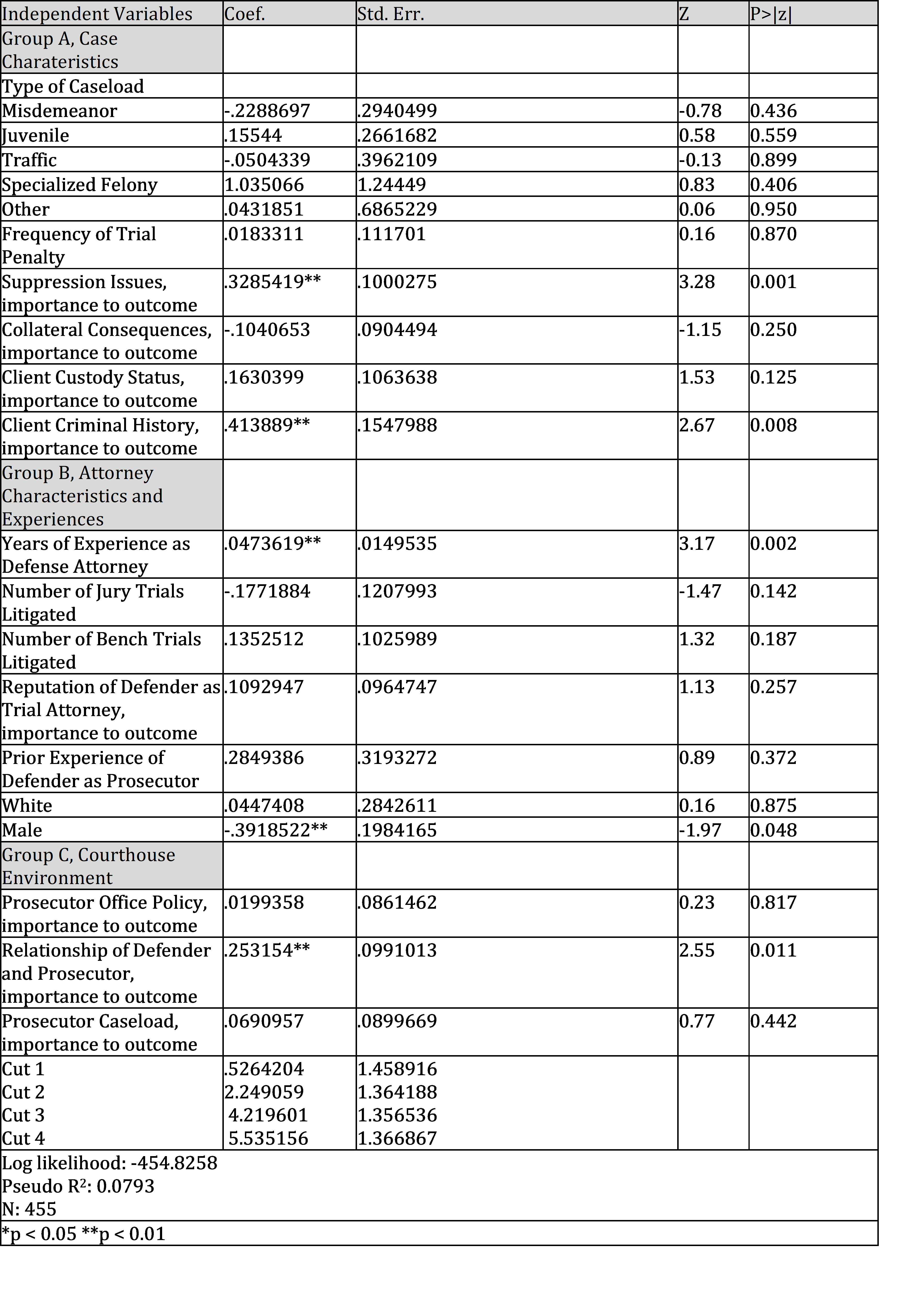 Model 1B, Dependent Variable = Sentence Prediction, Importance to Preparation for Bargaining
Model 1B, Dependent Variable = Sentence Prediction, Importance to Preparation for Bargaining
Shadow-of-Trial Indicator 2
Model 1C, Dependent Variable = Clear Sense of Client Goals, Importance to Preparation for Bargaining
Shadow-of-Client Indicator 1
Model 1D, Dependent Variable = Knowledge of Alternatives to Prison, Importance to Preparation for Bargaining
Shadow-of-Client Indicator 2
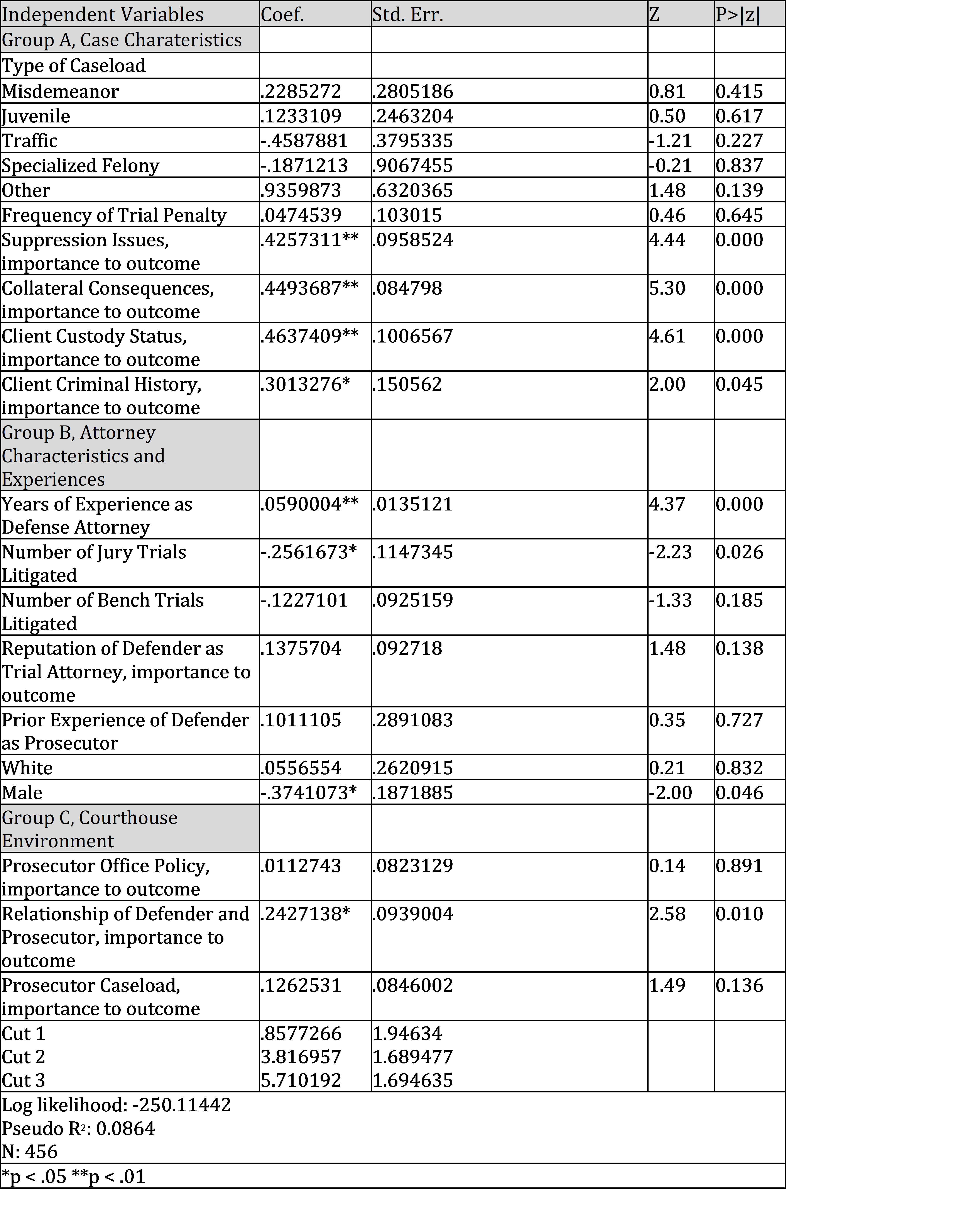 Model 2A, Dependent Variable = Trial Outcome Prediction, Importance to Preparation for Bargaining
Model 2A, Dependent Variable = Trial Outcome Prediction, Importance to Preparation for Bargaining
Shadow-of-Trial Indicator 1
 Model 2B, Dependent Variable = Sentence Prediction, Importance to Preparation for Bargaining
Model 2B, Dependent Variable = Sentence Prediction, Importance to Preparation for Bargaining
Shadow-of-Trial Indicator 2
Model 2C, Dependent Variable = Clear Sense of Client Goals, Importance to Preparation for Bargaining
Shadow-of-Client Indicator 1
Model 2D, Dependent Variable = Knowledge of Alternatives to Prison, Importance to Preparation for Bargaining
Shadow-of-Client Indicator 2
 Model 3A, Dependent Variable = Frequency of Bargaining About Collateral Consequences
Model 3A, Dependent Variable = Frequency of Bargaining About Collateral Consequences
Model 3B, Dependent Variable = Frequency of Signals Regarding Vigorous Motions Practice
Model 3C, Dependent Variable = Frequency of Bluffing About Potential Defenses at Trial
Model 3D, Dependent Variable = Frequency of Sharing Information with Prosecutor
The results presented in the Appendix tables reveal some noteworthy trends as to the impact of case characteristics (Group A) on the attorneys’ preparation for bargaining (Models 1A through 2D). Emphasis on suppression issues is positively related to the importance that attorneys place on several factors that matter during preparation for bargaining (see Models 1A, 1B, 1D, 2A, and 2D). Placing high importance on clients’ criminal history is positively related both to shadow-of-trial indicators during preparation (Models 1A, 1B) and to one shadow-of-client indicator (Model 1D). As we expected, believing that collateral consequences are important to the case outcome is associated most frequently with shadow-of-client indicators (Models 1C, 1D, and 2D), but we were surprised to see that it is also associated with one shadow-of-trial indicator (Model 2A). Client custody status is positively related to the value that prosecutors place on shadow-of-client indicators during their preparation for bargaining (Models 1C, 1D, and 2D).
When it comes to the influence of attorney characteristics and experiences (Group B), we found surprising results. While we did not hypothesize that gender was correlated with valuing any particular type of preparation for bargaining, we found that identifying as male is negatively related to the importance that individuals place on shadow-of-trial factors (Models 1A and 2A) and shadow-of-client factors (Models 1D and 2D) during preparation for bargaining. The number of years of experience as a defense attorney is mostly associated with shadow-of-trial factors (Models 1A, 2A, and 2B) but also with one shadow-of-client factor (Model 1D). Prior experience serving as a prosecutor is positively related to a shadow-of-client preparation activity (Models 1C and 2C) and a shadow-of-trial preparation activity (Model 2B). The number of jury trials litigated is negatively related to a shadow-of-client preparation activity (Models 1D and 2D) and to a shadow-of-trial preparation activity (Models 1B and 2B).
We find mixed results regarding the influence of courthouse environment factors (Group C). Although most of the courthouse environment factors had no significant effect, valuing the relationship of the defender and prosecutor is positively related to shadow-of-trial indicators of bargain preparation (see Models 1A and 1B) and to one shadow-of-client indicator (Models 1D and 2D).
As to beliefs about negotiation, our results reveal strong associations. Attorneys who emphasize the importance of knowing the probability of conviction also put extra weight on two shadow-of-trial preparation activities (Models 2A and 2B) and one shadow-of-client preparation activity (Model 2D). An abstract belief in the importance of the client’s wishes was positively associated (unsurprisingly) with knowing about client priorities and learning about alternatives to prison as important aspects of preparation for bargaining (Models 2C and 2D). An abstract belief in the importance of the likely sentence in the case is associated with efforts to predict the likely outcome at trial and sentence in preparation for the negotiations (Models 2A and 2B).
